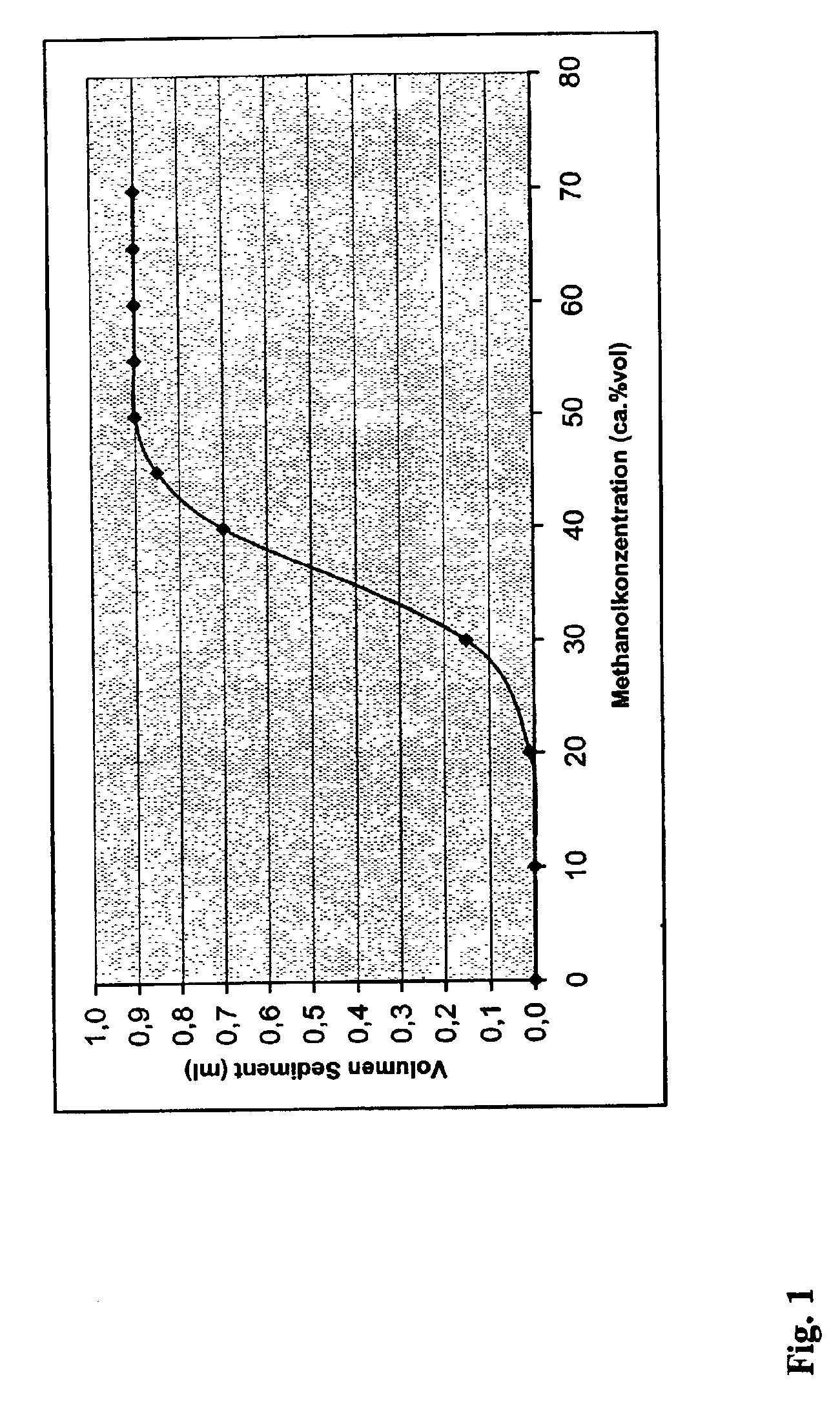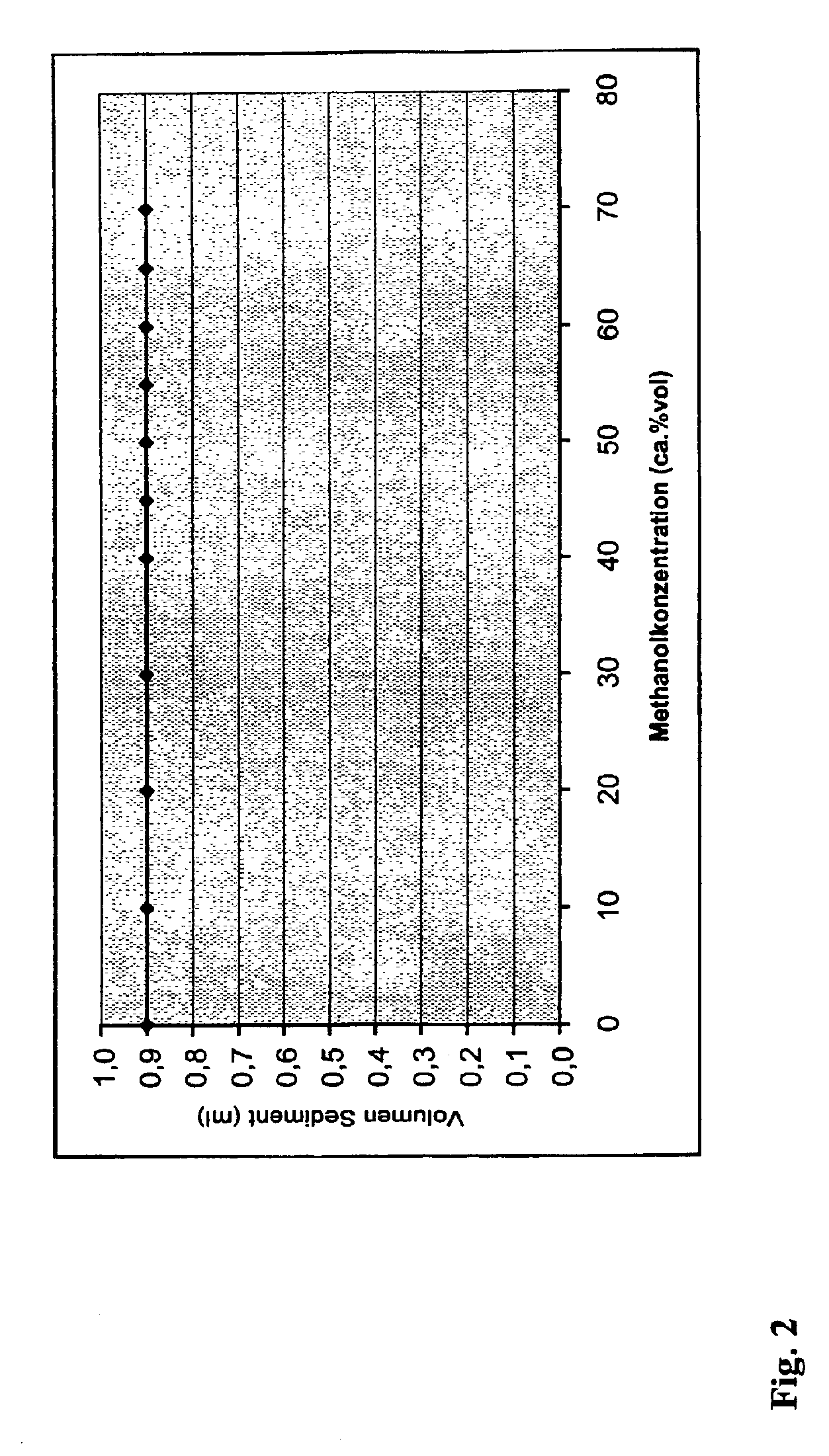High-whiteness, non-heat-treated hydrophobic precipitated silica
a precipitation silica and hydrophobic technology, applied in the field of hydrophobic precipitated silica, can solve the problems of high cost, inconvenient discoloration of hydrophobicized silica, and high temperature of required process temperature, and achieve good reinforcing properties of silicone rubber and high whiteness
- Summary
- Abstract
- Description
- Claims
- Application Information
AI Technical Summary
Benefits of technology
Problems solved by technology
Method used
Image
Examples
example 1
[0286]Drying and coating of the base silica with silicone oil (e.g., DOW CORNING (R) 200 FLUID 50 CS, carbon content about 33%, viscosity of 50 mPas) is carried out by means of a spin-flash dryer. The silica is then conditioned (aged at room temperature for at least 48 hours) until it has a methanol wettability of least 20%. The analytical data of the conditioned silica are given in table 1.1.
[0287]
TABLE 1.1Analytical data of the conditioned silicaWater%5.2pH6.1ConductivityμS41N2 surface aream2 / g84CTAB surface aream2 / g132Tapped densityg / L317Alpine SR > 180 μm%63Reflectance%95.9C content%4.12Methanol wettability%>20
example 2
[0288]The base silica is coated with silicone oil dimethylpolysiloxane, 50 mPas, e.g. DOW CORNING (R) 200 FLUID 50 CS, carbon content approximately 33%) in a Gericke mixer in a mass ratio of 1:1. The resulting powder is conditioned for an hour at a temperature of 105° C. This produces a material in which, although it is wettable by water, the silica and silicone oil can no longer be separated from one another in water. Mixing of this masterbatch with filtercakes of the base silica produces stable formulations in which the silicone oil no longer separates from the hydrophilic filtercake. A hydrophobic masterbatch and a hydrophilic filtercake thus prepared are conveyed together into the spin-flash drier, in which they are mixed and dried. The dimethylsiloxane-treated silica is conditioned by aging at room temperature for at least 48 hours (about 3 days) until it has attained a methanol wettability of at least 20%. The analytical data of the conditioned silica are given in table 2.1.
[0...
example 3
[0290]The initial distribution of silicone oil (viscosity of 50 mPas, methyl-terminated, e.g., DOW CORNING (R) 200 FLUID 50 CS, carbon content approximately 33%) on the silica (in the form of filtercakes) takes place in a spin-flash drier, with simultaneous drying. The dimethylsiloxane-treated silica is conditioned by aging at room temperature for 48 hours (about 3 days) until it has attained a methanol wettability of at least 20%. The analytical data of the conditioned silica are given in table 3.1.
[0291]
TABLE 3.1Analytical data of the conditioned silicaWater%5.2PH6.1ConductivityμS41N2 surface aream2 / g84CTAB surface aream2 / g132Tapped densityg / L317Reflectance%95.9C content%4.12Methanol wettabilit%>20
PUM
| Property | Measurement | Unit |
|---|---|---|
| particle size | aaaaa | aaaaa |
| water content | aaaaa | aaaaa |
| temperatures | aaaaa | aaaaa |
Abstract
Description
Claims
Application Information
 Login to View More
Login to View More - R&D
- Intellectual Property
- Life Sciences
- Materials
- Tech Scout
- Unparalleled Data Quality
- Higher Quality Content
- 60% Fewer Hallucinations
Browse by: Latest US Patents, China's latest patents, Technical Efficacy Thesaurus, Application Domain, Technology Topic, Popular Technical Reports.
© 2025 PatSnap. All rights reserved.Legal|Privacy policy|Modern Slavery Act Transparency Statement|Sitemap|About US| Contact US: help@patsnap.com



